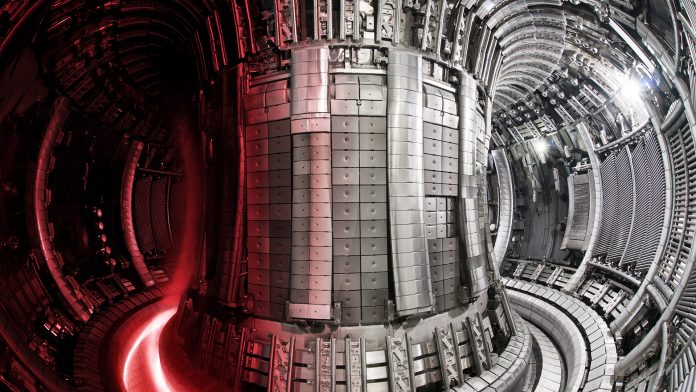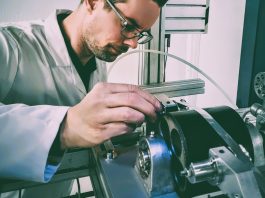Karl Tischler from the European fusion research consortium EUROfusion discusses the potential of fusion energy in achieving global decarbonisation.
The energy landscape is rapidly evolving as the urgency to reduce carbon emissions and achieve energy security grows. Fusion energy, long seen as a scientific dream, is now approaching a pivotal moment that could redefine how we power our world. With strong partnerships between the public and private sector, science and industry are integrating their approaches to fusion power.
As a potential source of clean, reliable baseload energy, fusion holds the promise of filling critical gaps left by existing renewable technologies like wind and solar. With recent breakthroughs and increasing investments, fusion energy is poised to emerge as a cornerstone of the future energy mix, complementing renewables and reshaping our path to a sustainable and resilient energy system.

Credit: EUROfusion Consortium and F4E
Fusion: The ultimate baseload power
Unlike renewable energy sources such as solar and wind, which are intermittent and dependent on weather conditions, fusion provides a consistent and reliable source of power. The fusion process combines atomic nuclei to release massive amounts of energy, just as they do in stars. This process has the potential to generate power 24/7, regardless of external conditions. Fusion’s fuels, deuterium and tritium, are derived from resources such as seawater and lithium. Because fusion requires ten million times less fuel than a coal-fired power plant to release the same amount of energy, it is not only sustainable but also secure against the geopolitical and supply chain risks associated with fossil fuels.
As an energy source, fusion is inherently safe, producing no carbon emissions, no long-lived nuclear waste, and no risk of a meltdown. The byproducts of fusion reactions are helium and short-lived, low- to mid-level radioactive materials that are far easier to manage compared to the high-level waste from fission reactors. This positions fusion as a uniquely clean baseload power source that can operate continuously, balancing the variability of other renewables and stabilising the grid.
Beyond power: Heat production and its applications
Fusion’s potential extends beyond electricity generation, as it also produces heat that can be harnessed for certain applications, such as district heating. Currently, the heat generated by fusion reactors is not suitable for all industrial processes, particularly those requiring very high temperatures, like hydrogen production or advanced manufacturing processes. This limitation arises because the heat must be kept below a certain threshold to maintain the reliability of materials like Eurofer steel, a reduced-activation ferritic/martensitic (RAFM) steel specifically developed for fusion environments.

Credit: UKAEA
However, this limitation is tied to the materials we use today. In the future, different materials may be developed that can withstand higher temperatures, opening the door to a broader range of industrial applications. With advancements in material science, it is possible that fusion-generated heat could be applied to more high-temperature processes.
Eurofer steel is designed to endure high radiation and temperature conditions typical of fusion reactors, making it essential for critical components such as the breeding blanket and divertor. However, exceeding certain temperature limits can compromise Eurofer’s structural integrity, which restricts its suitability for some high-temperature industrial uses compared to heat from fission reactors. Despite this, material innovations on the horizon might enable fusion reactors to generate heat suitable for more demanding industrial applications.
Fusion heat offers a valuable resource for district heating and other moderate-temperature applications, contributing to fossil fuel reduction in residential and some commercial settings. As material technologies evolve, so too will the potential uses of fusion heat, possibly transforming its role beyond moderate applications and extending into a wider array of industrial processes.
EUROfusion: Leading the charge toward a fusion-powered future
EUROfusion, Europe’s premier fusion research consortium, is at the forefront of this transformation. Our mission goes beyond advancing fusion science; we are committed to bringing fusion to the market as an integral part of Europe’s decarbonised energy portfolio.
EUROfusion’s research supports ITER, the world’s largest fusion experiment in southern France, where 35 nations collaborate to demonstrate the scientific and technological feasibility of fusion energy. Our work directly contributes to overcoming the remaining technical hurdles, ensuring that fusion will be ready to complement existing energy sources within the next few decades.
EUROfusion’s leadership in fusion research is not just about scientific achievement; it is about creating a sustainable, economically viable energy future. Our strengths lie in our global expertise, our collaborative spirit, and our ability to bring together a cohesive research community that now seeks to expand and forge strong partnerships with industry and private fusion ventures as equal partners. This approach has already led to significant advancements in plasma physics, materials science, and reactor design, paving the way for fusion to become a practical and competitive energy source.
The role of fusion in the future energy mix
As the world moves towards electrification, particularly in sectors like transportation, heavy industry, and data centres, the demand for reliable and clean energy will only intensify. Fusion offers a unique synergy with renewable energy. By providing consistent baseload power, fusion can reduce the need for large-scale battery storage and grid-balancing technologies, which are costly and resource-intensive. This integration could result in a more resilient and cost-effective energy system, where renewables provide variable power and fusion ensures a steady supply, optimising the overall performance and reliability of the grid.
Overcoming challenges and looking ahead
While fusion’s potential is enormous, challenges remain. The transition from experimental reactors to commercial power plants requires significant investment, regulatory clarity, and continued technological innovation. Recent advancements, including achieving net energy gain – measuring the energy produced by fusion reactions compared to the energy delivered to the fuel – have invigorated global interest and investment. However, this measure does not yet account for the total energy required to operate the system, underscoring the need for further development.
EUROfusion is committed to addressing these challenges head-on, working closely with international partners in research and industry to bring fusion energy from the laboratory to the power grid. Our efforts align with broader global goals of achieving climate neutrality, with the understanding that fusion’s major impact will be felt after 2050. Fusion is poised to help meet the growing energy demands of a transitioning world, ensuring that the benefits of this clean, safe technology are shared globally, supporting energy justice by enabling all countries to power their societies and fuel their development.
Next great leap
Fusion represents the next great leap in energy technology – a leap that EUROfusion is leading with vision, innovation, and collaboration. As we stand on the brink of realising fusion’s potential, we invite policymakers, industry leaders, and the public to join us in supporting this revolutionary technology. Fusion is more than just a scientific milestone; it is the future of clean, reliable, and abundant energy that will power the next generation and beyond.
With fusion, we have the opportunity to redefine baseload energy and secure a sustainable future for all.
Please note, this article will also appear in the 20th edition of our quarterly publication.









